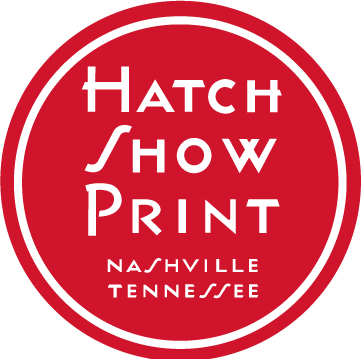As happens, the holidays crept up on us like a hungry cat . . . you know, the one you don’t hear until you look down and it’s right there, pacing figure eights in and around your legs and howling for supper?
Fortunately, before we got caught up in the paper chains and jolly Santas, we were able to kick off a couple of projects that included all of the traditional Hatch Show Print processes of setting type, selecting imagery, and getting inky, plus the added steps it takes to go virtual, including scanning, re-sizing, creating patterns, layering, separating, and tweaking (isn’t that the official word for tediously cleaning up the details?).
The first project celebrates a couple of interesting fonts, or sets, of type we have in the collection, type that we don’t often use in our regular work of designing and printing posters. The typeface’s technical name is Ionian, and it was introduced to printers by the William H. Page wood type manufacturers, around 1872. To print a letter completely, three separate wood blocks are required. Fortunately, each block is the same size, so lining them up to print well (registration) is fairly easy. Over the 140 years or so that this type has been in existence, some of the blocks have shrunk or warped some, and when we print the type, we must remember that.
To use this beautiful type to make a complete set of coffee cups for our retail shop (Yes! You can purchase all twenty-six letters, plus the ampersand and exclamation mark!), we carefully printed each block of each letter and the two extra figures—a total of eighty-four blocks—with black ink on tracing paper. Next, each piece of tracing paper was scanned, to make a high resolution digital file of each of the layers. For each of these scans, there was a bit of clean up, to maintain some of the qualities of the aged type, and to keep it from being too smooth and perfect. All three parts for each letter were layered together, just to make sure they fit, and dropped into the template the manufacturer provided (to meet their pre-press requirements). In addition to a letter on each coffee cup, there is a bit of hand typeset fun on the other side too, colored to match the three colors in the letters.
In addition to the coffee cups, postcards (printed from the wood type) and coasters (printed digitally) were simple and fun projects that celebrate this incredible type!
The next project was a bit more involved, much more like the design work we’re accustomed to doing on posters: Heather was given the job of designing and preparing for production a set of alphabet puzzle blocks. We hope it won’t spoil the ending to see the results first.
Every design element in these blocks was pulled from the shop’s collection. Knowing her copy (the alphabet), and the goal for illustrating the copy (an image of an object whose name starts with one of the letters of the alphabet), Heather started exactly where we start all of our work: pulling type from our cases, and selecting handcarved image blocks from the wall of type.
Because the design needed to be completed on the computer, Heather locked up the images she selected in the press bed as efficiently as she could and printed them with black ink on white paper. She did the same with the type.
These prints were scanned with high fidelity and resolution, so that the edges of the type and imagery stayed crisp, and Heather spent some time lost in the details of each image and letter, so that every one of them would be clean and easy to read once it was reproduced on a puzzle piece.
Once again working with the manufacturer’s template, Heather created a digital layer for each color, to be printed onto the wood, including two repeating background patterns that had to line up properly from one color to the next.
But she wasn’t done yet. All of our image blocks, carved by hand, vary in size from a few picas (about half an inch) to over twelve inches tall, and Heather edited each one, to fit consistently and proportionately on the puzzle piece. She even carved a new image, for “Y,” to complete the alphabet.
These puzzle sets are made in in Chicago , so the digital files did not have far to travel, but they are printed by hand, like our posters, and we waited patiently for them to arrive. (The puzzle pieces are screenprinted, a different process from the letterpress printing we do here at the shop.)
And, just like the arrival of ol’ Kris Kringle, it felt like Christmas morning the day they got here.
